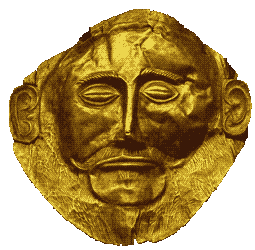
'Mask of Agamemnon' from Mycenae, Greece, discovered by Heinrich Schliemann in 1876 at Mycenae.
Agamémnon (Greek: Αγαμέμνων, Αγαμέμνονας ) ("very resolute"), one of the most distinguished of the Greek heroes, was the son of King Atreus of Mycenae (or Argos) and Queen Aerope, and brother of Menelaus. Another account makes him the son of Pleisthenes (the son or father of Atreus), who is said to have been Aerope's first husband.
Atreus was murdered by Aegisthus, who took possession of the throne of Mycenae and ruled jointly with his father Thyestes. During this period Agamemnon and Menelaus took refuge with Tyndareus, king of Sparta, whose daughters Clytemnestra and Helen they respectively married. By Clytemnestra, Agamemnon had three daughters, Iphigeneia, Electra, Chrysothemis, and a son, Orestes.
Menelaus succeeded Tyndareus, and Agamemnon, with his brother's assistance, drove out Aegisthus and Thyestes, and recovered his father's kingdom. He extended his dominion by conquest and became the most powerful prince in Greece.
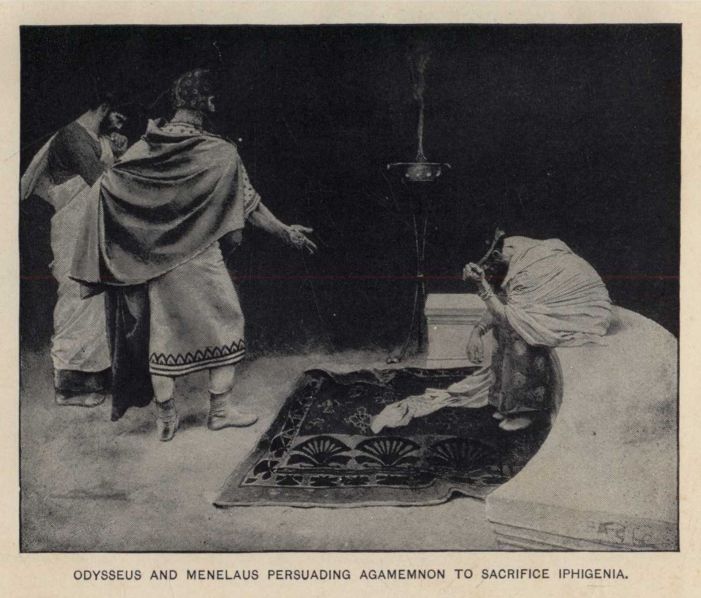
ODYSSEUS AND MENELAUS PERSUADING AGAMEMNON TO SACRIFICE IPHIGENIA.
Agamemnon took part in the Trojan War on the side of the Greeks. Before Agamemnon's fleet left for Troy, however, the winds suddenly stopped and the ships would not move from Aulis, a port in Boeotia; Agamemnon had offended the goddess Artemis by slaying a hind sacred to her and boasting himself a better hunter. The army was visited by a plague, and the fleet was prevented from sailing by the total absence of wind. Calchas announced that the wrath of the goddess could only be propitiated by the sacrifice of Iphigeneia (daughter of Agamemnon). Agamemnon agreed and sacrificed her. Alternatively, Artemis accepted a deer in her place and took Iphigeneia away to Crimea where she prepared others for sacrifice to Artemis. Still others sources claim he was prepared to but Artemis whisked her to Taurus in Crimea. Hesiod said she became the goddess Hecate.
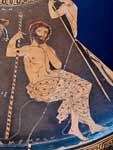
During the Trojan War, Agamemnon killed Antiphus. Agamemnon's teamster, Halaesus, later fought with Aeneas in Italy.
Little is heard of Agamemnon until his quarrel with Achilles. Agamemnon took the maiden Briseis as his own and Achilles was angry--their anger forms one of the major plot points of the Iliad. After the capture of Troy, Cassandra, the daughter of Priam, fell to his lot in the distribution of the prizes of war.
On his return, after a stormy voyage, he landed in Argolis or was blown off course and landed in Aegisthus' country. Aegisthus, who in the interval had seduced Clytemnestra, invited him to a banquet at which he was treacherously slain, Cassandra also being put to death by Clytemnestra. According to the account given by Pindar and the tragedians, Agamemnon was slain by his wife alone in a bath, a piece of cloth or a net having first been thrown over him to prevent resistance. Her wrath at the sacrifice of Iphigenia, and her jealousy of Cassandra, are said to have been the motives of her crime. The murder of Agamemnon was avenged by his son Orestes.
Although not the equal of Achilles in bravery, Agamemnon is a dignified representative of kingly authority. As commander-in-chief, he summons the princes to the council and leads the army in battle. He takes the field himself, and performs many heroic deeds until he is wounded and forced to withdraw to his tent. His chief fault is his overweening haughtiness, due to an over-exalted opinion of his position, which leads him to insult Chryses and Achilles, thereby bringing great disaster upon the Greeks.
But his family had been marked out for misfortune from the outset. His kingly office had come to him from Pelops through the blood-stained hands of Atreus and Thyestes, and had brought with it a certain fatality which explained the hostile destiny which pursued him.
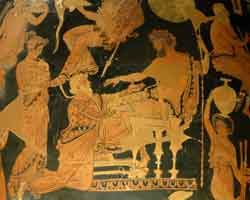
Chryses attempting to ransom his daughter Chryseis from Agamemnon
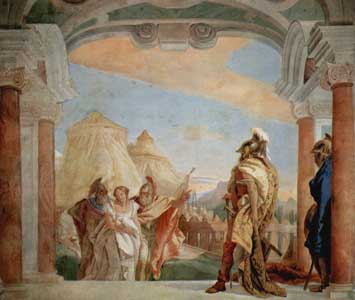
Eurybates and Talthybius lead Briseis to Agamemnon
The fortunes of Agamemnon have formed the subject of numerous tragedies, ancient and modern, the most famous being the Oresteia of Aeschylus. In the legends of Peloponnesus, Agamemnon was regarded as the highest type of a powerful monarch, and in Sparta he was worshipped under the title of Zeus Agamemnon. His tomb was pointed out among the ruins of Mycenae and at Amyclae.
In works of art there is considerable resemblance between the representations of Zeus, king of the gods, and Agamemnon, king of men. He is generally characterized by the sceptre and diadem, the usual attributes of kings.
Rod of Rule
Agamemnon is esp famous for carrying a "rod of rule" which is not just a normal kings sceptre, but is a specially crafted rod designed to bring heavenly power to its carrier so much so that even Achilles, the most noted warrior of this time was afraid of Agamemnon.
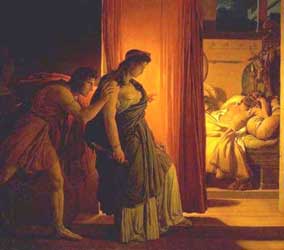
The Murder of Agamemnon , Pierre-Narcisse Guérin (1774 - 1833) , Louvre, Paris
The Ambassadors of Agamemnon in the Tent of Achilles
Agamemnon In Modern Fiction
Modern writers of time travel and historical novels often attempt to show the Trojan War "as it really happened", based on the archeological evidence of Mycenian civilization. Such authors frequently use Agamemnon as the archetypical Mycenian king, bringing life to old artifacts by dressing a familiar face in them. Of particular interest is S. M. Stirling's time-travel trilogy "Island in the Sea of Time", "Against the Tide of Years" and "On the Oceans of Eternity", where the fate that befalls the House of Atreus is every bit as horrific as that portrayed in traditional myth. The ironic thing is that the horror is arranged by a time-travelling villain who is very well aware of the mythology.
Agamemnon makes an appearance in the film Time Bandits, played by Sean Connery, although his depiction in the film seems more reminiscent of Odysseus.
Homer, Iliad; Homer, Odyssey I, 28-31; XI, 385-464; Aeschylus, Agamemnon (play); Aeschylus, The Libation Bearers; Sophocles, Electra; Euripides, Electra; Apollodorus, Epitome, II, 15-III, 22; VI, 23.
911 Agamemnon is a Trojan asteroid
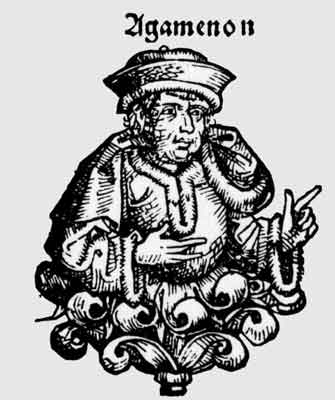
Agamemnon, Hartmann Schedel , Die Schedelsche Weltchronik , 1493
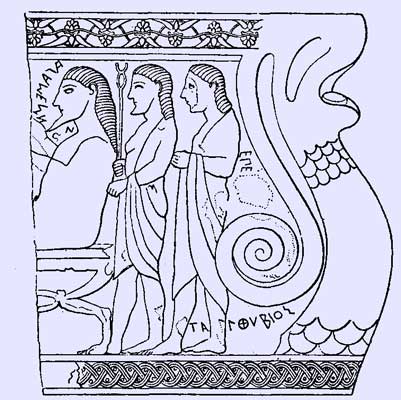
Agamemnon, Talthybius and Epeius, Relief from Samothrace
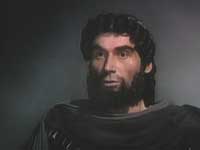
Agamemnon in the Ulysses 1955 Film
Electra at the tomb of Agamemnon, Sir William Blake Richmond
See also : Greek Mythology. Paintings, Drawings
A - B - C - D - E - F - G - H - I - J - K - L - M -
N - O - P - Q - R - S - T - U - V - W - X - Y - Z
Α - Β - Γ - Δ - Ε - Ζ - Η - Θ - Ι - Κ - Λ - Μ -
Ν - Ξ - Ο - Π - Ρ - Σ - Τ - Υ - Φ - Χ - Ψ - Ω
Retrieved from "http://en.wikipedia.org/"
All text is available under the terms of the GNU Free Documentation License
| Ancient Greece
Science, Technology , Medicine , Warfare, , Biographies , Life , Cities/Places/Maps , Arts , Literature , Philosophy ,Olympics, Mythology , History , Images Medieval Greece / Byzantine Empire Science, Technology, Arts, , Warfare , Literature, Biographies, Icons, History Modern Greece Cities, Islands, Regions, Fauna/Flora ,Biographies , History , Warfare, Science/Technology, Literature, Music , Arts , Film/Actors , Sport , Fashion --- |

